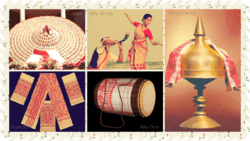Deori people
| Total population | |
|---|---|
| 47000-48000[1] | |
| Regions with significant populations | |
| Assam, Arunachal Pradesh, | |
| Languages | |
| Deori | |
| Religion | |
| Hinduism |
| Part of a series on the |
| Culture of Assam |
|---|
 |
|
Protohistoric
Ancient Medieval Colonial |
|
|
|
|
Festivals
|
| Religion |
|
History
Archives
Genres
Institutions Awards Asam Sahitya Sabha Award • Kamal Kumari Foundation Award • Krishnakanta Handique Award |
|
Music and performing arts |
|
The 'Deori' is one of the major indigenous communities of Arunachal Pradesh and Assam, India. They historically live in the upper plains or also called as the hinterland of the Brahmaputra Valley. The Deori community belongs to the Sino-Tibetan family of Mongoloid stock (as is generally the case of the people of northeast India).
The people of Deori tribe are mainly divided into four groups or clans, namely Dibongia, Bor-geeya, Tengaponiya and Pator-goya. The entire people of each main clan or main group are again subdivided into several sub-clans or sub-groups. The word "sub-clan" or "sub-group" is called "Boja" or "Bahor" in Deori language. Each Deori people wants to know or wants to inform about their main clan and sub-clan (sub-group) in their first introduction. Otherwise, their introduction remains incomplete.
History
History says that the homeland of the Deoris is in the North Eastern states of India or in the east of undivided Assam and Arunachal Pradesh. As per the folklore of the tribe, they initially settled in the Sotai hills which are located in today's Sonitpur district (previously known as Hadapeshvar). For unknown reasons, they migrated to the northeast and settled in Sadiya region. Deoris believed that they were once the priests of the Kamakhya temple which they recall in their folktales and songs. According to the book Mataks and their kingdom,[2]
Some experts claim that the Patorgoyan clan assimilated with the Tiwa tribe in central Assam but there has been no scientific evidence to support the claim, which prompted a section of Deoris to begin a search. A preliminary investigation from September 30 to October 5 under the aegis of Jimachaya Giyan Aru Juktibadi Samaj has given positive indication of the presence of Deori people in Kachin province and near Yangon in Myanmar. A team of researchers has decided to visit Myanmar in search of the lost clan.[3] Only the people of Dibongiya class can speak their own mother tongue, and almost all the other classes mysteriously lost their language. The three classes of Deoris live in the districts mentioned above.
Notes
- ↑ "Estimates using Census Report 2001".
- ↑ Dutta, Sristidhar (1985). The Mataks and their kingdom: castes and tribes of Assam. Allahabad, Uttar Pradesh: Chugh Publications. OCLC 13959339.
- ↑ http://www.thehindu.com/news/national/other-states/to-myanmar-in-search-of-a-lost-clan-of-the-deoris-tribe-of-assam/article6485876.ece
External links
| Wikimedia Commons has media related to Deori people. |